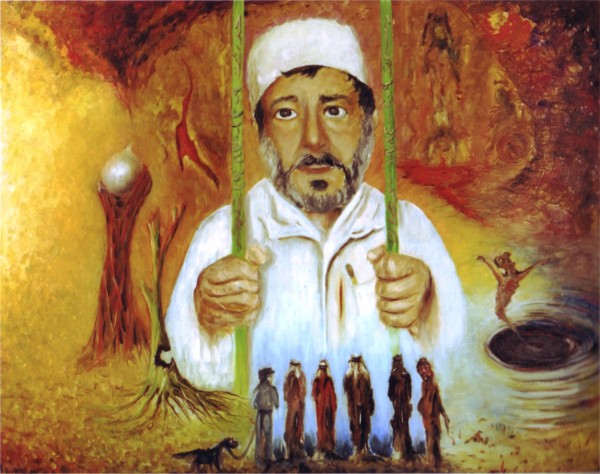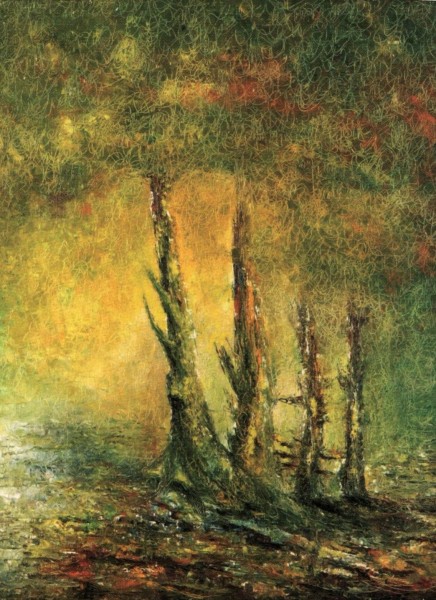
During [1. This analyses of Qattan’s work is an extract from my History of Art PhD thesis.] a period of personal depression in the 1980s, Khalifa Qattan produced what has become one of his most famous paintings, The Deep Wound, pictured above. The painting contains several elements which I will first point to, and then discuss how they were analysed symbolically by Lidia Qattan, adding my own thoughts on their possible interpretation.
It is a self-portrait in which an imprisoned, long-bearded and wounded Qattan looks straight at the viewer. The main figure is faced by six Arabian men observing him, with some sort of an animal. There is also a whirlpool, from which a figure similar to a Jinni is emerging (or being sucked in), and a fiery cave with another figure hanging upside-down from its feet. Two strange looking tree trunks can be seen: one green and decayed or cut, and one red and carrying an egg-shaped white object. The green tree trunk looks like a hand reaching for the taller red one. In the background we see a cracked wall and a pillar of fire and smoke. On the two prison bars the figure is holding is written in Arabic: ‘Happened 9-12-1983 Khalifa‘ and ‘Painted 9-2-1984 Qattan‘. It is very rare for Qattan to sign and date his work, therefore one is led to believe that the writing on the bars is not a mere signature, but part of the work itself. The date and signature are another symbol (or in Peircean theory an indexical sign), placed intentionally in the painting by Qattan. Lidia Qattan tells us that the artist painted this work ‘as a spontaneous reaction to a traumatic experience that befell Khalifa and left a deep scar in his soul‘.[2. Lidia Qattan, Prophosy of Khalifa Qattan, Kuwait, 1991, p. 84] We do not know what the direct cause of this traumatic experience was. Khalifa and Lidia Qattan on the other hand have associated this painting with events that happened more than six years later, giving it what could be called a ‘prophetic’ merit.
The symbols of The Deep Wound, though intentionally chosen by the artist as a representation of a personal ‘traumatic experience‘, were in 1991 read in a different way. In The Prophesy of Khalifa Qattan, Lidia Qattan interprets the symbols of The Deep Wound as relating to the events of the Iraqi invasion of Kuwait, which started on August 2nd, 1990. According to Lidia Qattan’s analysis, the sadness on the figure’s face represents the feelings of Kuwaitis after the tragic events that followed the invasion; there is the shock of the event itself and of the atrocities that followed it. The long beard resembles the appearance of many Kuwaiti men who let their beards grow during the months of the occupation due to a general feeling of depression or to the lack of men’s toiletries, which started to run out before the end of the occupation. The wound on the figure’s chest signifies the stab of the Arab neighbour, and the hands holding the green bars signify the solidarity of Kuwaiti people during the months of the crisis. The six Arabian spectators, according to Lidia, stand for the six Arab nations who stood with Saddam against Kuwait in the meetings of the Arab League, the countries of Al Dhed (الضد opposition) as they became known to Kuwaitis [3. The countries of ‘opposition’ are those Arab countries that did not support the Arab League resolution passed on 3/8/1990 condemning the Iraqi invasion of Kuwait. Those countries are: Jordan, Yemen, Sudan, Tunisia, Libya, Algeria, Mauritania, Iraq and the Palestinian Liberation Organisation.], and the small animal represents the Palestinian Liberation Organisation, since Palestine was not a country in its own right. The crack on the wall can also be interpreted as a symbol of the rift that opened up between the Arab nations as a result of this war. The whirlpool and the figure emerging from or being sucked into it is Iraq, with all the trouble caused to it by this war. The tortured figure hanging from its feet represents the mutilated bodies of Kuwaiti and Arab men and women who had been tortured by the Iraqi soldiers and intelligence agents (Mukhabarat). The tall red tree, according to Lidia Qattan, symbolises the hand of the Kuwaiti resistance, holding a bomb or explosives, while the green one is the spirit of Kuwaitis after the liberation: damaged, but ready to rebuild the ruined country. I would argue that another possible interpretation, based on Circulism’s symbolic system, is that the white egg shape is the spirit of Kuwaitis held high in the sky, since white in Qattan’s table of colour meanings [3. See The Apple] represents purity and faith, which could hardly describe a bomb. Since green is the colour of jealousy and envy, the green tree could be a hand reaching for that white spirit, trying in vain to destroy it. Finally, the fire and smoke bring to mind the burning oil wells sabotaged by the Iraqis, causing a blackened sky and long-lasting destruction to the environment.

The Deep Wound was not the only painting to be reinterpreted or reread in the light of the events of the Iraqi invasion of Kuwait and the Gulf War. Fifty-two other paintings that had been produced by Khalifa Qattan before the 1990s were exhibited in Kuwait and abroad in a show entitled The Prophesy, which was intended to narrate the story of the invasion and the war. Khalifa and Lidia Qattan probably intended the show to be an expression of patriotism, which was a common feeling among Kuwaitis at the time. During the Iraqi occupation Qattan did not paint any work related directly in its subject matter to the situation in which he was living; instead he continued working on the trees series he had begun during the late-1980s. The trees he painted may not have the symbolic power of his other Circulist works, but instead expressed the feeling of personal depression and helplessness. The depression deepened during the days of the occupation, but Qattan could not express his feelings freely in his art. There was a danger that the Iraqi Mukhabarat might suspect his intentions if he were to paint subjects criticising the occupation or even referring to it. Being a Kuwaiti painter was dangerous enough at that time, since there was a fear that artists would be forced to cooperate with the occupiers and paint in support of the Iraqi propaganda. The trees Qattan painted were executed in harsh, fast knife or brush strokes, with bold, strong colours, such that some of the trees showed a resemblance to the darkened skies and burning land he saw or imagined Kuwait as.